Python 演算法 Day 12 - Weak Learning
Chap.II Machine Learning 机器学习
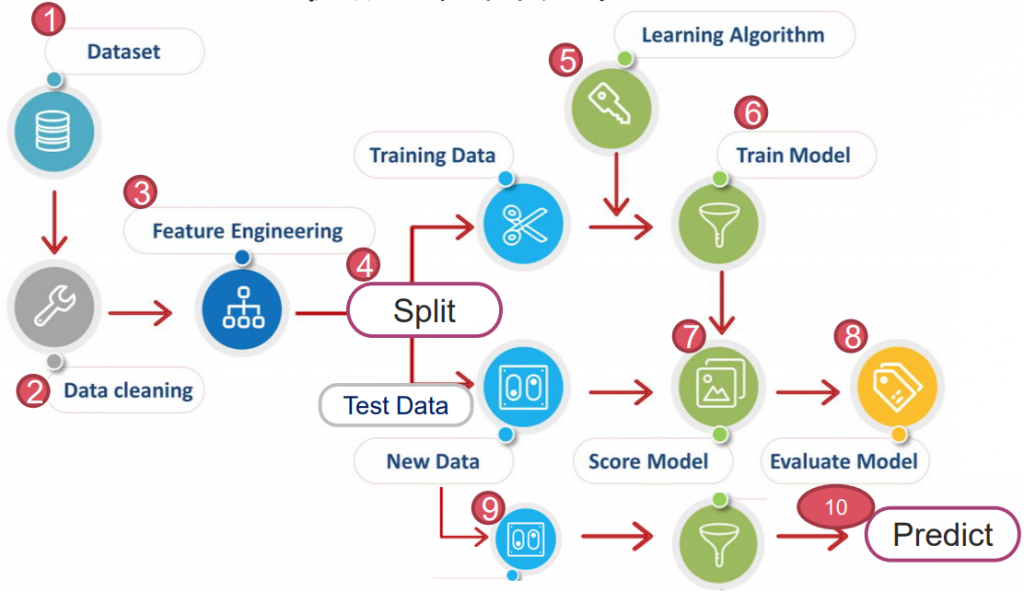
https://yourfreetemplates.com/free-machine-learning-diagram/
Part 3. Learning Algorithm 演算法
本篇会着重在先前提过的监督式学习上。
依据资料类型不同,监督式学习又分以下两种:
Classification 分类
资料集以"有限的类别"分布,对於其做归类,即分类。
Regresssion 回归
资料集以"连续的方式分布",对於其以线性方式描述,即回归。
3-1. Weak Learning 弱学习器
概念是由 Michael Kearns 提出,指一个训练模型结果只比随机分类好一点的演算法,称弱学习器。
反之,强学习器则是指经演算法训练後,模型预测结果非常接近真实情况。
以下会以 breast_cancer(Classification)资料来介绍常见的弱学习器:
import pandas as pd
from sklearn import datasets
ds = datasets.load_breast_cancer()
X=pd.DataFrame(ds.data, columns=ds.feature_names)
y=pd.DataFrame(ds.target, columns=['Cancer'])
from sklearn.model_selection import train_test_split
X_train, X_test, y_train, y_test = train_test_split(X, y, test_size = 0.3)
from sklearn.preprocessing import StandardScaler
sc = StandardScaler()
X_train_std = sc.fit_transform(X_train)
X_test_std = sc.fit_transform(X_test)
A. K-Nearest Neighbors (KNN) 最近距离法
寻找距离预测值最近的 N 个样本点,以多数决(Majority Voting)决定所属分类。
优点:实现只须两个参数 P & 距离函数。
缺点:无法应用於高维度,且不适用类别(定性)特徵(如性别、星期几...等非数字资料)。
常用於推荐商品。
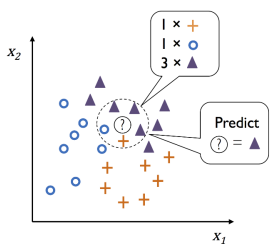
from sklearn.neighbors import KNeighborsClassifier as knn
clf = KNN(n_neighbors = 3)
clf.fit(X_train_std, y_train)
clf.score(X_test, y_test)
>> 0.9707602339181286
超参数:
1. n_neighbors: 预测值须取多少临近点比较。为避免平局常取奇数。
2. metric: 计算距离的公式。
B. Logistic Regresssion 罗吉斯回归
其为线性回归的改良版。(数学原理可参考:推导1、推导2 & 推导3)
优点:Outlier 影响小(上下限 0~1),可线性分割。平滑曲线,变异性小。
缺点:无法应用於高维度、易未拟合,且对於非线性特徵要额外转换。
常用於二分类。
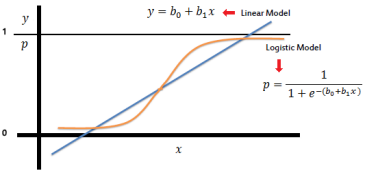
from sklearn.linear_model import LogisticRegression as LR
clf = LR(penalty='l2', C=0.01)
clf.fit(X_train_std, y_train)
clf.score(X_test_std, y_test)
>> 0.9649122807017544
超参数:
1. penalty: 正则化参数。预设 l2。(详细解说)
L1: 将没有用的权重设为0,留下模型认为重要的权重
L2: 削弱所有权重(但仍保留),让所有权重与神经元都处於活动状态。
2. C: 正则化强度的倒数。C 越小,矫正强度越大(使训练分数降低、预测资料变准)。
C. Support Vector Machine 支援向量机(SVM)
如图,距离 model(方程序)最近的点,称为 Support Vector 支援向量,
而 positive Hyperplane & negative Hyperplane 彼此间距为 margin。
其根本目的为找到一个 Decision Boundary,使切割的 margin 越大越好。
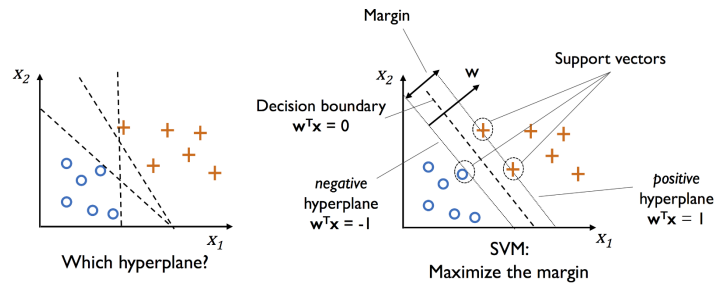
优点:Outlier 影响小(仅边界影响),且记忆体用量小。高维资料表现好。多样核函数以应对资料。
缺点:样本数大时效能差(须来回优化),成本贵。
from sklearn.svm import SVC
clf = SVC(C=1, probability=True)
clf.fit(X_train_std, y_train)
clf.score(X_test_std, y_test)
>> 0.9649122807017544
可以查看其参照多少支援向量:
len(clf.support_vectors_)
>> 97
超参数:
1. C: 正则化强度的倒数。C 越小,矫正强度越大(使训练分数降低、预测资料变准)。
默认 1(hard margin,尽可能找出完美超平面,下图左)。
若 C=0.01,则模型评分会下降至 0.66。
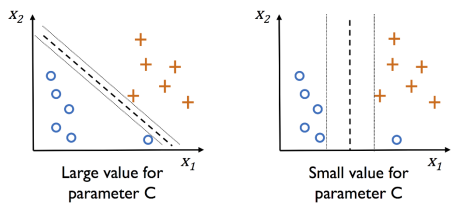
2. kernel: 同 PCA,有 {‘linear’, ‘poly’, ‘rbf’, ‘sigmoid’, ‘precomputed’} 等分类方式。
若使用 'linear' 分析圆形资料,评分会下降许多
3. probability: True 才能使用 predict_proba 呼叫机率。
PS. 此外,sklearn 有提供三种线性分类写法:
# 1. 较常使用
LinearSVC(C=1, loss='hinge')
# 2. 执行效能较差
SVC(kernal='linear', C=1)
# 3. 适合记忆体有限(训练资料很庞大) or Online Training
SGDClassifier(loss='hinge', alpha=1/(m*C))
D. Decision Tree 决策树
透过 training data 的 fearture 学出一系列的问题,然後来推断其分类。
演算法
A. Sklearn 使用的是 Classification and Regression Tree (CART)
特色为依照数值型特徵切割,且一次切割只分为两个点,但同一特徵可多次切割。
B. Chi-squared Automatic Interaction Detection (CHAID)
所有变数转成不连续的组距(discretecized),切割可大於两个点。
C. 其他还有 ID3、ID4.5、ID5.0、Decision Stump、M5...等。
Information gain 信息增益
为了能在节点上使用最具意义的特徵来分割,我们会透过信息增益来判断。
信息增益越大,那此「分类」对於决策树来说就越重要,表示它能把数据分的越乾净。
所谓的信息增益,可用以下方式表达:

常见信息增益计算:
A. Gini Impurity 吉尼不纯度:
计算一「随机样本」被某个「分类 x 」分错的概率。不纯度越低,表示该分类方法越显着有用。

Ex. 假设分类後仅剩下 1 种特徵,则 Ig = 1-(1+0) = 0,为一个不纯度最低的完美分类方法。
(多考虑纯度,故比起 Entropy,分类效果较好)
B. Entropy 熵:
类似热力学,但在资讯理论中多了负号。熵高(负少)传输资讯多,熵低(负多)则传输资讯少。

C. Classification Error 分类错误率:
很直观,即分类错误的最小机率。

优点:易於了解与解释(可视觉化)。资料仅须少量前处理(不需常态/标准化)。无复杂计算。
缺点:易过拟合,需搭配特徵选择减少特徵量。不平衡样本(得病/无病)差距太多,会使分割偏向多数样本方,需使用 class balancing 技术(如 SMOTE)矫正。
程序码
*注意!!! 决策树演算不需要标准化/正则化的!!!
它们不关心特徵「值」,只关心特徵「分布」和特徵间的「条件概率」
import pandas as pd
from sklearn import datasets
ds = datasets.load_breast_cancer()
X=pd.DataFrame(ds.data, columns=ds.feature_names)
y=pd.DataFrame(ds.target, columns=['Cancer'])
from sklearn.model_selection import train_test_split
X_train, X_test, y_train, y_test = train_test_split(X, y, test_size = 0.3)
决策树:
from sklearn.tree import DecisionTreeClassifier as DTC
clf = DTC(criterion='gini', max_depth=3, random_state=1)
clf.fit(X_train, y_train)
clf.score(X_test, y_test)
>> 0.9064327485380117
超参数:
1. criterion: 不纯度方法,'gini'(默认) & 'entropy'。
2. max_depth: 树的层数。若 None 则扩展节点至所有叶包含 min_samples_split 样本。默认 None。
3. min_samples_split: 分裂一个内部节点所需的最小样本数。默认 2。
更多参数看 DecisionTreeClassifier或 DecisionTreeRegressor
要让决策树视觉化,需安装以下两个程序:
-
Graphviz (官方网站)
下载後,进入主机(右键)内容 -> 进阶系统设定 -> 环境变数 -> Path
并新增"C:\Users\User.conda\envs\tensorflow-gpu\Lib\site-packages\graphviz\bin" -
使用 pip 安装 pydotplus
pip install pydotplus
正式使用:
# 作图
from pydotplus import graph_from_dot_data
from sklearn.tree import export_graphviz
dot_data = export_graphviz(clf,
filled = True,
class_names = ds.target_names,
feature_names = ds.feature_names,
out_file = None)
graph = graph_from_dot_data(dot_data)
graph.write_png('Pic\Cancer tree.png')
# 显示图片
from IPython.display import Image
Image(filename='Pic\Cancer tree.png', width=1000)
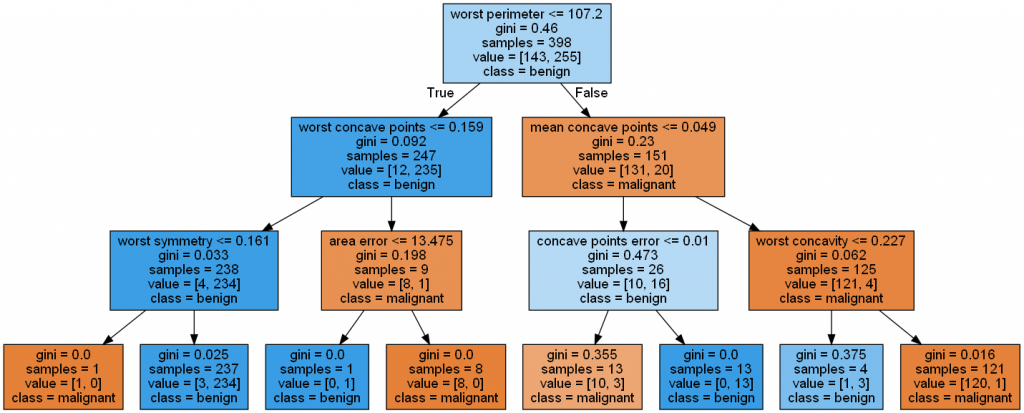
另外,Decision Tree 也可以应用於回归类型的资料,见补充 4.。
结论:
- KNN: 实现仅需两参数。但高维表现弱。可用於推荐商品。
- Logistic Regresssion: 以 0~1 分割资料。但高维表现差。可用於二分法演算。
- SVM: 边界影响小,高维表现好,可分析多种类型(如圆球形)资料。但耗时长成本高。
- Decision Tree: 可视觉化,资料不需前处理。但易过拟合,且若样本差距过大需矫正。
- Random Forest: 高维表现好,能平衡资料误差。但记忆体消耗高,且无法针对单一树解释。
.
.
.
.
.
*补充 1.:Gini Impurity
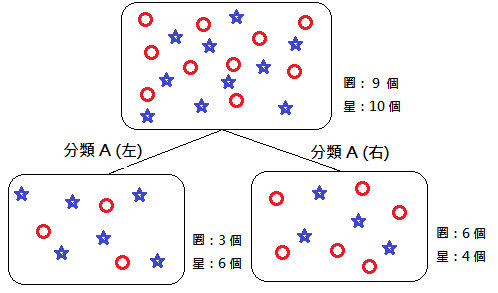
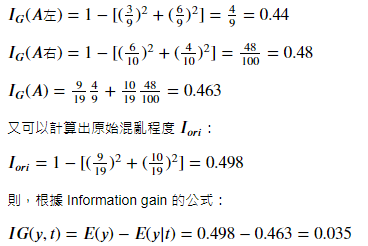
*补充 2.:Entropy

左右两边的 Etropy 算出来皆为 0.5,但
*补充 3.:客户留存率与流失率
*补充 4.:Decision Tree 回归 Boston
from sklearn.datasets import load_boston
from sklearn.tree import DecisionTreeRegressor as DTR
import pandas as pd
ds = load_boston()
X=pd.DataFrame(ds.data, columns=ds.feature_names)
y=pd.DataFrame(ds.target, columns=['Boston'])
from sklearn.model_selection import train_test_split
X_train, X_test, y_train, y_test = train_test_split(X, y, test_size = 0.3)
clf = DTR(max_depth=2, random_state=1)
clf.fit(X_train, y_train)
clf.score(X_test, y_test)
>> 0.6865210494380858
.
.
.
.
.
Homework Answer:
试着用 sklearn 的资料集 breast_cancer,操作 Featuring Extraction (by PCA)。
# Datasets
from sklearn.datasets import load_breast_cancer
import pandas as pd
ds = load_breast_cancer()
df_X = pd.DataFrame(ds.data, columns=ds.feature_names)
df_y = pd.DataFrame(ds.target, columns=['Cancer or Not'])
df_X.head()

# define y
df_y['Cancer or Not'].unique()
>> array([0, 1])
# Split
from sklearn.model_selection import train_test_split
X_train, X_test, y_train, y_test = train_test_split(df_X, df_y, test_size=0.3)
X_train.shape, X_test.shape
>> ((398, 30), (171, 30))
from sklearn.decomposition import PCA
pca1 = PCA(n_components=2)
X_train_pca = pca1.fit_transform(X_train)
X_test_pca = pca1.transform(X_test)
X_train_pca.shape, X_test_pca.shape
>> ((398, 2), (171, 2))
# Modeling (by LogisticRegression)
from sklearn.linear_model import LogisticRegression as lr
clf = lr(solver='liblinear')
clf.fit(X_train_pca, y_train)
print(clf.score(X_test_pca, y_test))
>> 0.9298245614035088
<<: 【Vue】串 API 前置作业|Axios 是什麽?
>>: 【2022 Mac必学】五 个方法救回 Word 当机未保存的文档
标签图片的方法与实作 - Day 12
标签图片的方法与实作 - Day 12 资料增量 (Data Augmentation) 的部份因为...
Day 7【钱包登入区 - Login Button】Kitten or Ice Cream?
【前言】 先来回顾一下 Day2 Project 分析的使用者流程,今天先来做第一步的 「登入按钮...
[Day20] - Django-REST-Framework Serializers 介绍
除了昨天介绍的 Viewset ,有另外一个大家不太熟悉但是看似又非常强大的 class,就是 Se...
[Day 08] tinyML开胃菜Arduino IDE上桌(上)
书接上回,讲了一大堆如何做出好吃的AI咖哩饭,那到底要如何开始才能当上新一代的「AI食神」呢? 首先...
Day5 State vs Props
前言 State跟Props这两个东西其实不会很难,却很重要,基本上你在写React的日子里都会一直...